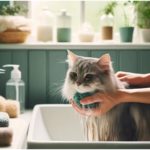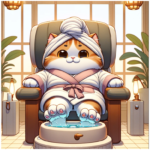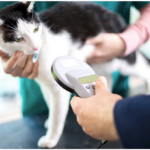If you’re a cat parent, chances are you’ve heard about claw caps as an option for managing your kitty’s claws and reducing damage to your furniture, your skin, or both. But before deciding if they’re the right solution for you and your feline friend, it’s important to understand what claw caps are, how they work, and their pros and cons. In this comprehensive guide, we’ll cover everything you need to know about claw caps for cats to help you make an informed decision.
What Are Claw Caps?
Claw caps, also known as soft claws or nail caps, are small, plastic covers that are glued onto a cat’s claws. These caps are generally made from a flexible, non-toxic material like silicone or vinyl, which allows them to fit snugly over the claw without causing discomfort to the cat.
The caps come in various sizes and colors and are usually applied to a cat’s front claws, though some pet parents use them on the back claws as well. They are designed to blunt the claws so that if the cat scratches, the damage is minimized or eliminated entirely.
How Are Claw Caps Applied?
Applying claw caps at home is relatively simple, though it may take some patience, especially if your cat is unfamiliar with the process. Here’s how it typically works:
- Trim the Cat’s Claws: Before applying the claw caps, you’ll need to trim your cat’s claws so they’re short enough for the caps to fit properly.
- Prepare the Caps: Squeeze a small amount of adhesive into the cap, ensuring it’s not too much to overflow once placed on the claw.
- Apply the Caps: Gently extend your cat’s paw and place the cap over each claw. Hold it in place for a few seconds to let the adhesive bond.
- Monitor the Caps: Once applied, it takes a few minutes for the glue to fully dry. During this time, it’s a good idea to distract your cat with play or treats to keep them from trying to remove the caps.
Pros of Using Claw Caps
Claw caps can be a helpful solution for some cats and their owners, offering several benefits:
- Furniture Protection: If your cat’s scratching habits are wreaking havoc on your furniture, claw caps can provide an immediate solution by blunting their claws. They still retain the ability to scratch, but they won’t cause damage.
- Prevents Injury: Cats with sharp claws can accidentally scratch their owners, other pets, or themselves. Claw caps reduce the risk of injury without removing the natural function of the claws.
- Humane Alternative to Declawing: Declawing is an invasive and painful surgery that permanently removes a cat’s claws, often leading to behavioral and physical issues. Claw caps are a humane, temporary alternative that leaves the claws intact.
- Safe for Cats: Most claw caps are made from safe, non-toxic materials. They don’t affect the cat’s ability to retract their claws and typically fall off naturally after 4-6 weeks as the cat’s claws grow.
- Aesthetic Appeal: For those who like a bit of flair, claw caps come in a variety of colors and patterns, allowing you to personalize your cat’s look.
Cons of Using Claw Caps for Cats
While claw caps are useful, they are not without their drawbacks:
- Not a Long-Term Solution: Claw caps are temporary and need to be reapplied every 4-6 weeks, which can be time-consuming for pet owners.
- May Interfere with Natural Behavior: Scratching is a natural and essential behavior for cats. It helps them mark territory, stretch their muscles, and remove the dead outer layer of their claws. With caps, they may not get the full benefits of scratching.
- Potential Discomfort: While most cats tolerate claw caps well, some may find them uncomfortable, especially if not applied correctly. Some cats may constantly chew at or attempt to remove the caps, leading to stress or anxiety.
- Difficulty with Outdoor Cats: If your cat is allowed outside, claw caps may not be ideal. Outdoor cats rely on their claws for climbing, defense, and hunting. Claw caps can blunt their natural defenses and leave them vulnerable to predators or other threats.
- Risk of Ingestion: Though rare, if a cat chews on or pulls off a cap, there is a small risk they could ingest it. Fortunately, most caps are designed to be non-toxic, but it’s still something to monitor.
Are Claw Caps For Cats Safe?
Claw caps are generally considered safe for most cats. The caps don’t restrict the natural movement of a cat’s claws, and when applied correctly, they cause no pain. However, as with anything involving your cat’s health and well-being, it’s important to keep a few safety considerations in mind:
- Monitor Your Cat’s Behavior: Some cats may try to chew the caps off. If your cat is showing signs of distress or discomfort, it may not be a suitable option.
- Keep Up with Regular Maintenance: Since claw caps fall off naturally as the claws grow, check your cat’s paws regularly to ensure no caps have come off or are causing issues. Reapplying caps as needed is part of their maintenance.
- Use Cat-Safe Adhesive: Always use the adhesive that comes with the claw cap kit, as it’s specifically designed to be safe for pets.
Who Should Consider Claw Caps for Cats?
Claw caps can be a great option for certain cats and their owners. You may want to consider claw caps if:
- You have an indoor-only cat who is scratching furniture or causing accidental injury.
- You’re looking for a humane alternative to declawing.
- You have small children or elderly individuals in the home who are more susceptible to accidental scratches.
- Your cat has certain medical conditions that make scratching themselves dangerous (for example, post-surgery cats who need to avoid reopening wounds).
Tips for Getting Your Cat Used to Claw Caps
If your cat is not used to claw caps, they might need some time to adjust. Here are some tips to help make the transition smoother:
- Start Slow: If your cat is resistant, start by applying caps to just one or two claws at a time to let them adjust.
- Offer Treats: Use positive reinforcement to reward your cat after applying the caps.
- Distract with Play: Engage your cat in a fun activity immediately after applying the caps to keep them from focusing on their new claw accessories.
- Consult Your Vet: If your cat seems to be in discomfort, consult with your veterinarian to ensure the caps were applied correctly and that there are no underlying health issues affecting their comfort.
Alternatives to Claw Caps for Cats
If claw caps don’t seem like the right option for your cat, there are alternatives that can help manage scratching behavior:
- Regular Nail Trimming: Keeping your cat’s nails trimmed can help reduce damage caused by scratching. You’ll need to trim them every couple of weeks.
- Scratching Posts and Pads: Providing plenty of scratching options can help redirect your cat’s natural scratching behavior away from your furniture.
- Sticky Tape: Some pet owners use double-sided sticky tape on furniture to deter cats from scratching. Cats dislike the texture, and it can help break the habit.
- Soft Paws or Furniture Covers: Protective coverings for furniture can help minimize damage without altering your cat’s behavior.
Final Thoughts: Are Claw Caps Right for Your Cat?
Claw caps can be a useful tool for managing your cat’s scratching habits, especially if you want a humane alternative to declawing. However, they aren’t a one-size-fits-all solution. Before committing, it’s essential to consider your cat’s personality, habits, and needs, as well as your own ability to maintain and reapply the caps regularly. When used responsibly, claw caps can offer a peaceful compromise between your cat’s natural behaviors and the protection of your home.
If you’re unsure whether claw caps are the right choice, consult with your veterinarian to get personalized advice tailored to your cat’s specific situation.






